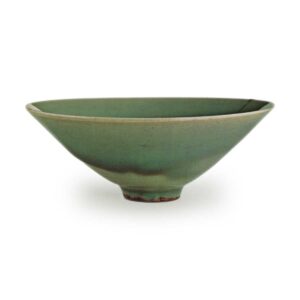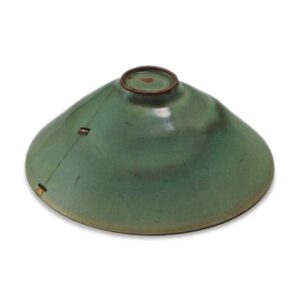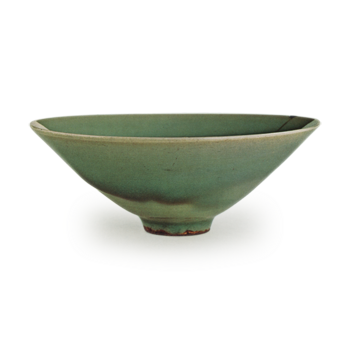

Rokuon-ji Temple
Height: 5.3-5.5cm
Diameter: 14.6-14.7cm
Base diameter: 3.4cm
Height: 0.6cm
The tea bowl was presented to the priest Hourin of Kinkakuji Temple, who is famous for his book “Kakutenki”, by Katagiri Sekishu, and has since been added to the temple’s treasures as a memento of the priest. It is a rare type of celadon tea bowl that has survived in Japan, and although the inscription on the box says it is from the Goryeo dynasty, it seems that it was already being treated as a Goryeo celadon when it was in the possession of Sekishu. However, looking at the body glaze and other aspects, it is actually thought to be a celadon from the Song dynasty, probably from the Longquan kilns.
The body is a grayish-white semi-porcelain body, densely fired, and the foot ring is yellowish-brown in color. The small, well-shaped foot ring has a refreshing curved surface that somehow also has an ancient feel to it, and it is thought to have been made during the Northern Song dynasty or around that time.
The overall shape is elegant and dignified. The glaze is a beautiful, clear light blue-green, smooth and vivid. It is said to be like a jade gem, translucent, but it is not polished, and it is thought that this is because the glaze was fully melted in the kiln and the fine bubbles in the glaze disappeared. Even though it is from the Longquan kilns of the same Song dynasty, the glaze of the “Full Moon” tea bowl has a different feel to it. This kind of transparent glaze is often seen in Goryeo celadon, and this is the reason why this tea bowl is considered to be Goryeo. However, here, a thick glaze has dripped on one part of the outside, and this has formed a state known as “makuyu” at the waist. The glaze color naturally becomes darker, and the deep shade of gray-green drifts about, creating a scene that is noticeably like a cloud hanging over the area. If we liken this to a rain cloud, is the key made of smoked silver that runs from the rim to the crack a dragon? It is easy to understand why it was named “Uryu”.
In this way, the tea ceremony was a way of appreciating and selecting tea bowls as works of art, and it was the tea master’s discernment. Although celadon tea bowls have to give way to tenmoku bowls when it comes to tea bowls, and from the time of Rikyu in particular, Chinese tea bowls tended to be avoided, the deep-rooted respect for celadon itself has been passed down to this day as famous bowls, such as the “Maboshi” bowl, and has been preserved.
As is written on the note on the back of the box lid, this tea bowl was presented to Hōrin on the first day of the second month of the leap year in the seventh year of the Kanbun era, when he visited Koizumi in Yamato. In the Hōrin Masahiro Diary, “Kakigi Ki”, in the section for the second month of the leap year in the same year,
On the fourth day…: I left for Kazusa on the 29th of the last month, and arrived at the residence of Katagiri, the governor of Izumo, where I was invited by the governor last year. (omission)
The 8th… This morning, I went to the residence of Katagiri Izumimori, and I went to the residence of Katagiri Izumimori, and I went to the residence of Katagiri Izumimori, and I went to the residence of Katagiri Izumimori, and I went to the residence of Katagiri Izumimori, and I went to the residence of Katagiri Izumimori, and I went to the residence of Katagiri Izumimori, and I went to the residence of Katagiri Izumimori, and I went to the residence of Katagiri Izumimori, and I went to the residence of Katagiri Izumimori, and I went to the residence of Katagiri Izumimori, and I went to the residence of Katagiri Izumimori, and I went to the residence of Katagiri Izumimori, and I went to the residence of Kat
On the 23rd, the tea master of the day, Katagiri Izumimori, was at Koizumi, and we were given tea. The tea bowls were also sent from Izumimori in Izumo.
We drank two cups of thick tea, and then left.
From this, we can well imagine the close relationship between Horin and Izumimori. Furthermore, the author of the box inscription, Keihiko, was a high-ranking disciple of Hōrin, the 14th abbot of Rokuon-ji and the founder of its revival, and was an important abbot at the temple. In the “Kakigi Ki” (Record of the Separation of the Tea Bowl), we can see that he was always by Hōrin’s side and received his love and care.
There are no other accessories to see, other than the paulownia box with the inscription by Keihiko.



